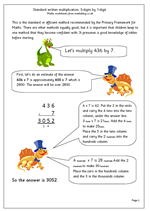 This worksheet uses the standard or efficient method recommended by the Primary Framework for Maths to multiply a 3-digit number by a single digit. There are other methods equally good, but it is important that children keep to one method that they become confident with. It presumes a good knowledge of tables before starting.
This worksheet uses the standard or efficient method recommended by the Primary Framework for Maths to multiply a 3-digit number by a single digit. There are other methods equally good, but it is important that children keep to one method that they become confident with. It presumes a good knowledge of tables before starting.
For example: 436 x 7.
First, do an estimate of the answer.
436 x 7 is approximately 400 x 7 which is 2800. The answer will be over 2800.
Then set the sum out in a vertical layout:
436
x 7
Start with the units.
6 x 7 is 42. Put the 2 in the units and carry the 4 tens into the tens column, under the answer line.
Then multiply the tens.
3 (tens) x 7 is 21(tens). Add the 4 (tens). to make 25(tens).
Place the 5 in the tens column and carry the 2 (hundreds) into the hundreds column.
Finally the hundreds.
4 (hundreds) x 7 is 28 (hundreds). Add the 2 (hundreds) to make 30 (hundreds).
Place the zero in the hundreds column and the 3 in the thousands column.
The answer is 3052.
A clearer layout of this is available on the worksheet explanation.
Further written multiplication worksheets can be found in the Year 5 and Year 6 Calculations sections.